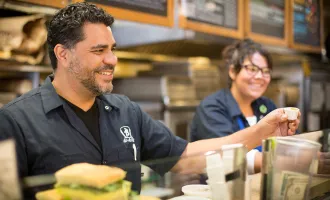Matt's Brined Thanksgiving Turkey
Adapted from The New Best Recipe by The Editors of Cook’s Illustrated and Ad Hoc at Home by Thomas Keller
OK, folks. The days are short, the pumpkins are melting, and all the stores have Christmas decorations. This can only mean one thing — Thanksgiving! In honor of those goofy little birds, I am breaking my normal scheduled broadcast to bring you what I believe to be the most delicious turkey recipe. I will say right up front that it is a lot of hard work that starts two to three days before you actually cook the bird, but it is well worth it.
That being said, there are a few ways to save time if you are in a pinch. First, you can skip boiling the brine. It is much better to not boil the brine than put a turkey into warm brine. Second, reduce the brine time. Even brining for four to six hours is enough to make the difference, so don’t skip it.
The one thing you really should not skip, besides cooking it, of course, is drying it overnight. It allows for the skin to brown, which seals in the turkey juices, making for the perfect bird. Lastly, you will notice that this turkey does not have any stuffing in it. That is intentional. If you add stuffing to this turkey, it will become very salty, due to the brine juices, and the cooking times will all increase. Thus, I really do not recommend stuffing the bird. I truly hope you enjoy this recipe and have a great Thanksgiving!
1 turkey (12–16 pounds)
3 medium onions, chopped coarse
2 medium carrots, chopped coarse
2 celery ribs, chopped coarse
3 tablespoons unsalted butter, melted
8 lemons, halved
24 bay leaves
1 bunches of flat-leaf parsley
2 bunches of thyme, separated
1 cup of clover honey
2 heads of garlic, halved through the equator
½ cup of whole black peppercorns
2 cups of kosher salt
3 large heavy-duty trash bags
This should be done the day before you plan on placing the turkey in the brine. Combine the lemons, bay leaves, parsley, honey, garlic, peppercorns, kosher salt and all the thyme (except for six sprigs) in a large pot of water and bring to a boil, stirring until the salt is dissolved. Remove from heat and allow to cool, then chill before using.
If you don’t have enough time to boil the brine, do not fret, just combine all the ingredients cold and follow the next steps. Open all three trash bags and place one inside the other so you have a brining bag that is three layers thick. Wash the turkey in plenty of cold water, making sure to remove the giblets inside, then place the turkey in the brining bag. Fill the bag with your brine mix, then add water until turkey is almost submerged. Seal each of the three bags one at a time, minimizing the amount of air in each one by slightly lifting the bag and sealing it as close to the turkey as possible. Place in refrigerator and let brine over night.
The next day, remove the turkey from the brine and rinse off to remove any extra salt or brining contents on the skin or inside the cavity. Pat the turkey dry, inside and out. Place on a sturdy flat rack over a cookie sheet breast side up and put back in refrigerator uncovered for 8 to 24 hours.
Adjust oven rack to the lowest position and preheat oven to 400 degrees. Toss one-third of the onions, carrots, celery and two sprigs of thyme with 1 tablespoon of melted butter. Place this mixture into the body cavity and tie the legs together so as to prevent the mixture from falling out.
Scatter the remaining vegetables and thyme in a shallow roasting pan, and pour 1 cup of water over them. Set a V-rack in the pan. Brush the entire turkey with the remaining melted butter and place breast side down.
Roast for 45 minutes. Remove the pan from the oven, making sure to close the door behind you, and baste with the juices from the pan. Safely turn the turkey onto its side with one leg/thigh side up. If the pan has become dry, add half a cup of water to the pan. Return to oven and roast for 15 minutes. Remove from oven, baste, flip to other leg/thigh side and return to oven for another 15 minutes. Remove the turkey from the oven, baste, turn it breast-side up and roast until the breast is about 165 degrees and the thigh is 170 to 175 degrees. This should be about 30 to 45 minutes. Remove the turkey from the pan and let it rest on the carving board for at least 20 minutes.
Note: If you don’t have a V-rack, don’t sweat it! Just place the bird in the pan on top of the vegetables instead. Then follow the recipe as written except for the two middle rotations. Instead of roasting it on its side, the first flip should be breast-side up, and the second flip should be breast-side down, and then the third and last flip should end as written with the breast-side up.


